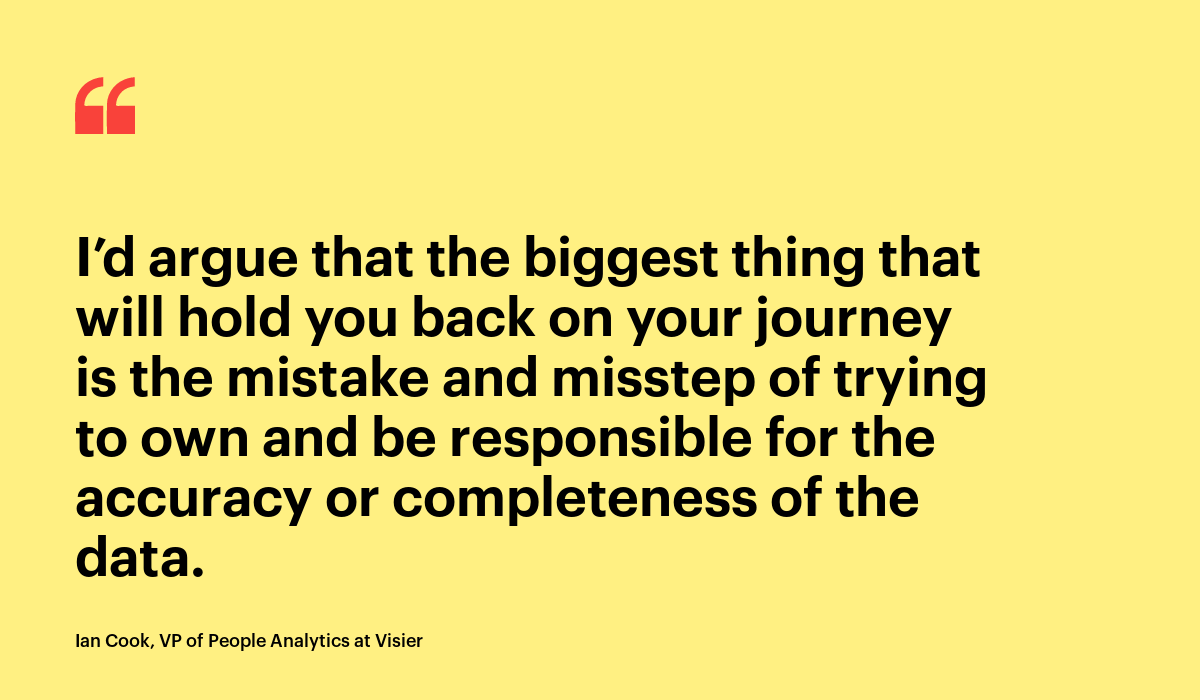People Analytics: 4 Tips for the Journey
People analytics experts share why the current business environment has increased the gap behind frontrunners and how to move data analytics beyond HR.

Experian’s Global Head of People Analytics, Technology & Strategy, Olly Britnell, and Visier’s Ian Cook joined Kate Graham for an UNLEASH webinar discussion on the opportunity, practicalities and top tips that will help you on the journey to unlocking the full potential of your enterprise people data ecosystem.
Speed of change
The past two years have seen an acceleration and sophistication in demand for people analytics (PA) within businesses. It’s a trend driven by a number of factors—tech players investing in big tech that captures and processes people data, bringing new services and options to enterprises, and also the entry of new, niche players in the market, which are presenting bespoke products to make businesses more successful and improve the working lives of employees.
There is now a new maturity within many HR functions when it comes to handling people data and how it can be combined with other data within an organisation, from finance, sales, to pipeline data, for example.
“There is a real recognition from leaders that HR should have a seat at the C-suite table, helping inform business decisions,” says Olly Britnell, Experian’s Global Head of People Analytics, Technology & Strategy. “The needs for understanding people through data have been escalated.”
From efficiency to effectiveness
HR is in the middle of a fundamental sea change, transforming from a function concerned with efficient administration—the fate of which is diminishing returns on investment—to one that now focuses on effectiveness and the question of how people matters and behaviours will help or hurt the business, now and in the future. Different organisations have grasped this truth to different degrees, and because of the aforementioned surge in demand for people analytics, the gap between those just starting out on their people analytics journeys and those surfing the wave of change is growing faster as well. “The Great Resignation is a good example of this” says Ian Cook, VP of People Analytics, Visier. “Companies are starting to get deep into the data, to find out where people leaving is hurting the business.”
The price of people analytics stock is on the rise
In recent times, the broader appetite in society for cultural change has meant topics such as gender pay and diversity have broken into the top three agenda items for many boardroom meetings. Such people metrics are becoming more embedded in corporate life, their function changing from a recording of what has happened and what has or hasn’t worked to a critical element of strategic decision making. Financial results alone are no longer the key driver of investor relations.
The fast pace of change requires quick thinking from organisations. “One of the ways we have been able to embed people analytics is by taking advantage of changing environments,” says Britnell.
“The pandemic and the so-called Great Resignation were both examples of instances when management were leaning heavily on traditional HR through lockdowns and subsequent shifts in working patterns. These were opportunities for us to engage with leaders, steer them from making purely instinctive decisions, dispel certain myths that they had about the people matters and behaviours, and open an array of helpful conversations about wellbeing, remote work, and the return to the office; things they would never have looked to us for previously.”
OLLY BRITNELL, EXPERIAN’S GLOBAL HEAD OF PEOPLE ANALYTICS, TECHNOLOGY & STRATEGY
People are the business
When the impacts of the pandemic on business kicked in, it became clear that people analytics advanced more deeply into organisations. “Visier saw a 40% spike in usage of its products,” says Cook. “That’s in real time queries from managers investigating the people they had, where they were, and what they knew about them. Since then, we’ve been expanding our footprint to accommodate measures we would have never expected, about new working patterns and vaccinations, for example.”
Businesses have shifted from an initial response schedule, which was to first reorganise their businesses and then sort their people out, to realising ‘Oh. The business is our people.’ People matters are now understood to be pressing enough for managers to know they could miss targets and have to shut down certain operations if they are not addressed.
Here are four tips for unlocking the full potential of people analytics within your business:
Establish a single version of truth
Avoid data quality traps
Identify which metrics to collect
Monitor hot topics and ‘provocative analytics’
1. Establish a single version of the truth
Different organisations are of course affected in different ways, but we have never quite been in this situation before, trying to support productivity with a newly distributed workforce and in the kind of labour market we’re seeing today.
At Experian, Britnell explains a set up many will be familiar with: a handful of significant HR systems, consolidated into a single view in Visier for optics on KPIs, metrics, and insights. “We have a product development team for analytics whose function it is to come up with new ways for our people to use, understand, and consume the data, so that they can make better decisions, and make them faster. We also feed into a data lake so that we are able to access numbers with consistency and have what’s sometimes referred to as ‘a single version of the truth.’”

2. Avoid data quality traps
It’s important to view the people analytics journey as just that, a journey to maturity, where you will be graduating from capturing basic people metrics to making forecasts and feeding into strategy, and from there onto an even higher plane creating ‘new knowledge’. “I’d argue that the biggest thing that will hold you back on your journey is the mistake and misstep of trying to own and be responsible for the accuracy or completeness of the data,” says Cook.
Data cleansing is a discrete task that shouldn’t be core to the people analytics function, but be the responsibility of those supplying the data. If you try and do everything manually you will hit a scalability wall and end up building a huge team doing low value work, or asking for more people to do work they shouldn’t really be doing.
“This is where Visier can help, to get you up and running on your journey in a matter of a few weeks,” says Cook. “When it comes to accuracy of data, there is likely to be a period when you are persuading the business that they can make judgements based on data that is not 100% accurate, nor 100% complete. This happens in every other walk of business and research, and so it should be with people analytics. Show your expertise by explaining to the business why and how they can make these decisions. Waiting for 100% is unnecessary, and in any case, you’ll never get there.”

Find out how organisations with a high level of maturity in people analytics drive value in our latest report The Age of People Analytics 2021.
3. Identify which metrics to collect
While there are some fundamental metrics that you want and need, such as attrition, headcount, hires, who’s leaving, and rates of progression in different functions and among different groups—this will generally be dependent on the individual business.
There is another layer of measures that echo and support where the whole business is going. For example, at Experian, it’s tech skills. “We’re moving towards a market position where we are perceived as more of a technology or software play, rather than a traditional financial services firm,” says Britnell. “This affects who we’re hiring and who we want to retain. So, again, for example, one perhaps surprising thing we’re looking at on this journey is our Glassdoor score.”
Building consistency but adaptability in local business units is fundamental to people analytics success. The data and methodology should come from one place, so each business unit can pull data in the same way, then apply it to different business challenges. “Centralising the delivery but shipping data out wholesale to five different business units will create five different answers, and also mean credibility damage for the people analytics cause within the business,” warns Cook.
4. Monitor hot topics and ‘provocative analytics’
What’s clear is that monitoring and improving intelligence on employees’ health, wellbeing, and the future of work more broadly will all play a part in organisations moving forward with their strategic goals. And it’s a distinct possibility that the pace and size of people analytics projects will shift again. “I see PA teams as becoming more agile, project-based, with the ability to pivot to serve strategic needs, build things that work, deliver, and move on,” says Britnell. “There will also be an advancement of ‘provocative analytics’—dispelling the myths of old and proving the opposite.”
Grabbing a hot topic and feeding it into the business is likely to have high engagement from leadership. “We were able to tap our metrics during lockdowns,” says Britnell, “to ascertain that our U.S. and UK workforces were adapting to remote work in very different ways. This was of intense interest to our leadership and another instance when we were able to gain attention and trust.”
“An example of such a hot topic to jump on right now and one that will be of interest to boards and leadership teams, is tying sentiment data to resignation data, to get a picture of what is going on under the bonnet of this fast moving and changing employment market,” Cook concludes.
Keeping pace with and overtaking competitors requires deft handling and a fast response time. People analytics teams can shine their headlights on hot topics or metrics whose importance has shifted. By providing a single version of the truth and avoiding data quality traps, good people analytics can drive companies to keep up with the speed of change.
Visier customers financially outperform their peers. Find out how organisations with a high level of maturity in people analytics drive value in our latest report The Age of People Analytics 2021.
Get Outsmart content straight to your inbox
Subscribe to the People Insights Monthly newsletter for actionable insights and stories.
Subscribe now